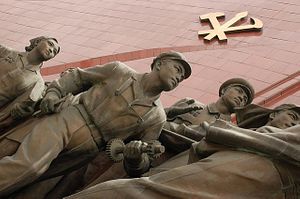Historically, market prices in North Korea (as reported by Daily NK) have tended to remain surprisingly stable throughout many periods of tension and crisis. At times, while the rest of the world has seemed to be running for the bomb shelters, market prices in North Korea have barely moved, suggesting a lack of belief within North Korea that sanctions will be implemented or that imports will get restricted as a result of the tensions.
This time, it’s different.
While DailyNK’s market price database has not been updated since August 4, news reports from inside North Korea suggest prices are much higher than they normally would be, as a result of news of added sanctions and an embargo on fuel sales to the country. Corn prices, for example, are reported to be 42 percent higher than what is normal at this time of year. The story here is that news of China’s participation in the sanctions regime give cause for worry on the ground, as is the bad harvest season:
According to inside sources, the cost of one kilogram of rice was about KPW 5,800 at the end of last month in Pyongyang, South Pyongan Province Sinuiju City, and Ryanggang Province Hyesan City. On September 5th, the prices passed the KPW 6,000 mark and have continued to slowly rise. After the North’s nuclear test, gasoline prices rose sharply around the country. Rice and other grains followed suit in due course.
Insiders located in the border regions near China – which have long served as hubs of trade and smuggling – are also sensing the climbing prices. A source from Ryanggang Province explained to Daily NK on September 11, “When we heard about economic sanctions in the past, there were merely slight increases in the cost of rice, but now we are seeing a different kind of effect.”
She continued, “Even though we are currently at the height of the corn harvest season, corn is nonetheless selling for KPW 2,700 per kilogram, [it sold for just KPW 1,900 per kg at the end of August]. Merchants haven’t been overly concerned until now, but now that we see corn prices increasing during the harvest season, it seems clear that the economic situation will continue to deteriorate.”
Witnessing the cost of diesel and gasoline spike upwards, some merchants have predicted that this will cause the price of other products to raise as well, and have therefore responded by reducing the number of products available for sale. By doing so, they hope to be able to sell at a higher price later. This reduced supply, in turn, has itself pushed prices up.
Also, as reports and rumors from the outside world penetrate further into North Korea, more and more people are coming to realize that North Korea’s closest friends, especially China, are meaningfully participating in the sanctions. This information also helps to push prices up.
A poor yield of corn this year is also playing a role. Severe droughts in the spring have hurt bottom line harvests of grains such as corn.
This should not come as a surprise. As external income sources are increasingly getting strangled by Chinese sanctions enforcement, the North Korean economy as a whole is feeling the pinch. Again, this is not at all a strange development. On the contrary, the remarkable resilience of North Korean market prices in past periods of tensions is the really peculiar story. Most likely, past rounds of the same –tensions followed by sanctions followed by tensions followed by eventual deescalation — has lacked a credible belief among North Koreans that China would really tighten the screws enough for the domestic economy to really take a hit.
It is still far too early to say anything about how long China will keep up the pressure, or how well the North Korean economy can adapt by, for example, switching over to fuels that are more abundantly available, such as liquefied coal. It’s also important to remember that oil and fuel has never been cheap in North Korea, and that many residents prefer solar panels instead of diesel-powered generators to cover their needs during the frequent power outages in the country. But none of these adaptions are cheap or easy. These things take time and effort, and real costs as well as opportunity costs are likely to be large.
To be sure, the regime very likely expected and planned for this outcome. The increase in gasoline prices over the past few months suggests that the state has been siphoning off fuel from the markets for quite a while, to fill up their own stockpiles. The climb in gas prices is not limited to Pyongyang, but extends to other regions as well. The pattern of nuclear- and missiles tests this year, as many have noted, also seem to be a signal of defiance toward China. Moreover, if regime survival is the ultimate goal of Pyongyang, it’s important to remember that only a few years ago, North Korea’s trade was a third of what it is today, and regime collapse wasn’t exactly on the radar. And again, sanctions pressure from China likely won’t last forever.
But the price trend in late August and early September is a reminder that the North Korean economy, after all, works according to the laws of supply and demand. Unlike at many previous occasions, China is — at least for now — clamping down on trade with North Korea, and its residents are feeling it.
Will sanctions be strongly enforced enough to cripple North Korea’s economy? Probably not. But there is a very wide range of states between crippled and unaffected, and while North Korea’s domestic economy may be very resilient, it is not beyond the reach of international tensions.
Benjamin Katzeff Silberstein is the co-editor of North Korean Economy Watch and an associate scholar with the Foreign Policy Research Institute.
This post was originally published by North Korean Economy Watch and appears with kind permission.

































